Heather Morning was appointed mountain safety adviser for the Mountaineering Council of Scotland in summer.
Her brief is to advise on all aspects of safety in the mountains, from avalanche awareness to technical skills and training. She has a wealth of experience: she was formerly a CairnGorm mountain ranger; she’s a Search and Rescue Dogs Association member and holds the Mountain Instructor Certificate, qualifying her to teach winter climbing techniques.
Heather’s interest in the concept of ‘mountain blackspots’ was prompted by a series of accidents over the last couple of years, some fatal, at certain places in the Highlands. Is there, she wonders, such a thing as a blackspot, and if so, how do we tackle the problem?
Here is Heather’s view on the subject.
Four incidents and two fatalities this summer, on or close to the Clachaig Gully path at the western end of the Aonach Eagach prompted me to consider the thorny issue of accident ‘blackspots’. Check out the UKClimbing forum and you will see for yourselves the massive interest in this.
Whether we like it or not, accidents in the mountains create emotive responses. The press loves to get hold of a mountain rescue story – the avalanche incident, resulting in three fatalities, in Coire na Tulaich on Buachaille Etive Mòr last winter resulted in a huge amount of press coverage.
Compare this to the press coverage of road traffic fatalities that occur on the UK roads every day.
Are there places we should avoid in the mountains? Are we putting ourselves at unnecessary – and in some folk’s eyes unacceptable – risk? Should a list be published and reviewed regularly of locations where accidents are occurring? Is there anything wrong with learning by other peoples mistakes? Or is there a bigger picture to consider here?
Warning signs
Should we be putting up warning signs? Do folk read them and if they do read them are they acted upon? Last winter following a spate of ten accidents in just over a week, Langdale and Ambleside Mountain Rescue Team, in conjunction with the local police, displayed warning signs at the main access points onto the high fells in Langdale.
The signs warned hillwalkers of ‘snow and ice on all upland paths above 300m’. However, despite the warnings, the rescue team continued to get called out to recover folk stuck on steep frozen ground.
The Clachaig Gully descent off the Aonach Eagach has historically been a well known hazard. Walter Poucher in his book The Scottish Peaks, first published in 1964, describes the Clachaig Gully descent off the ridge: “It is also possible to descend a steep, stony path following the west side of the Clachaig Gully. In wet weather or poor visibility the descent is quite unpleasant and exposed in places. Considerable care should be taken.”
Some readers will also remember the warning sign located at the Am Bodach layby at the eastern end of the ridge, warning climbers not to consider descending off the ridge prior to the final summit of Sgorr nam Fiannaidh.
Nanny State
I suspect many of us head into the mountains to get away from our increasingly litigious and sanitised world. We go there to challenge ourselves, both physically and mentally; to make very real decisions that have very real consequences. Do we want to see a ‘via ferrata’ rigged across the pinnacles on the Aonach Eagach? Would a sign warning of the dangers of descent down the Clachaig Gully side be acceptable on the summit of Sgorr nam Fiannaidh? How about a line of cairns guiding folks down the south side of the ridge towards Loch Achtriochtan or north towards the Pap?
A considerable amount of money has been spent on the summit of Ben Nevis to do just that. A series of large well constructed cairns guide folk to and from the summit, around the top of Gardyloo Gully and past the potentially dangerous ground of Five Finger Gully. These cairns were built in the summer of 2008 and follow the line of the traditional ‘pony track’, but they are not without contention. Discussions are ongoing as to whether the close proximity of some of the cairns to the precipitous North Face is likely to lure somebody over the edge in winter conditions.
Numbers game
Research into the Scottish Mountain Rescue statistics reveals the accident hotspots. Of course it doesn’t take a genius to work out that the largest number of accidents happens where the largest concentrations of people go.
Take the tourist track up Ben Nevis, due to the Ben’s accolade of being the highest mountain in the UK it attracts huge numbers of people. Recent figures from the Glen Nevis Ranger Service suggest two hundred thousand people per year ascend the mountain via the tourist track alone. By the law of averages the more people there are, the more accidents are going to happen.
In the five years from 2004 to 2008 there were 101 rescue callouts for Lochaber Mountain Rescue Team to incidents on the tourist track. That makes it the highest number of callouts to one specific location in Scotland.
Does that then put the tourist track at the top of the blackspot league tables? Is Ben Nevis a killer mountain? Realistically, the answer has to be a resounding no!
For your average hillwalker the tourist track is an easy, well constructed path all the way. It’s the people who are on the path that causes the problem. This may be because of poor fitness levels, predisposed medical conditions, inadequate clothing and equipment, lack of navigation skills and poor general hill sense. For many Ben Nevis ascensionists may even be their one and only mountain climb.
The mountain-rescue statistics also reveal the accident blackspot hotspots in Glencoe, the Aonach Eagach and Buachaille Etive Mòr not surprisingly coming out on top. In the five years from 2004 to 2008 there were 32 incidents on the Aonach Eagach closely followed by 29 incidents on the Buachaille. This again reflects the popularity of these locations. There are plenty of other places in Glencoe, due to the nature of the steep terrain where an accident could occur.
Heading east to the Cairngorms, the Northern Corries in winter have to be the classic black spot hotspot. There are literally hundreds of folk on a good day walking into Coire an t-Sneachda and Coire an Lochain to enjoy the winter mountaineering and climbing which is so accessible from the road. The Northern Corries alone accounted for 38 call outs for the Cairngorm Mountain Rescue team in the same five year period.
Any answers?
We are increasingly living in a society which likes to attribute blame. A recent coroner’s report on a fatality on Ben Nevis in January 2008 draws upon Rule 43: “In the coroner’s opinion, action should be taken to prevent the occurrence or continuation of such circumstances, or to eliminate or reduce the risk of death created by such circumstances. Additional safety measures should include more visual and audio warnings of possible dangers.”
I am not sure if visual and audio warnings are appropriate or effective. There are already signs at the Glen Nevis visitor centre to educate folk on the appropriate clothing, equipment and experience necessary for a safe ascent of the mountain. Perhaps the way forward is to encourage and foster a culture of self reliance through the provision of training.
You wouldn’t think it was acceptable to jump in a car and drive without having some professional instruction first. Should venturing into the mountains be any different? The Mountaineering Council of Scotland, the body which represents the interests of Scottish climbers and hillwalkers, promotes the importance of self-reliance in the mountains. Through their mountain-safety initiatives the council offers subsidised training course in mountain skills. Current courses on offer can be viewed at on the MCofS website.
In conclusion, I would suggest that it is not the mountains that are the killer. It is folk with inadequate experience and equipment who are exposing themselves to a greater level of risk.
Many thanks to Bob Sharp for his kind support and information regarding accident statistics.
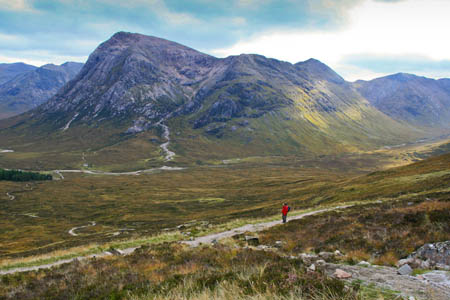
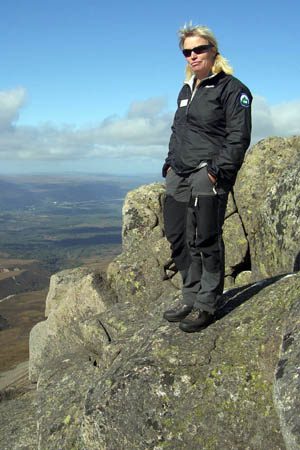
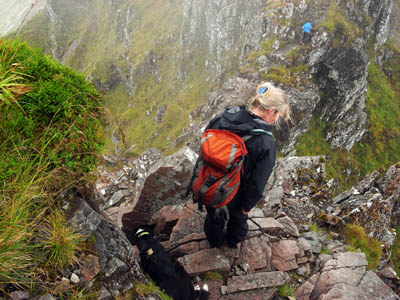
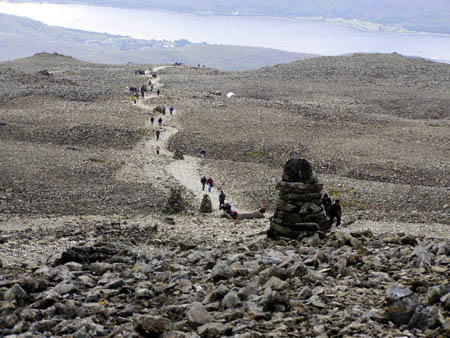
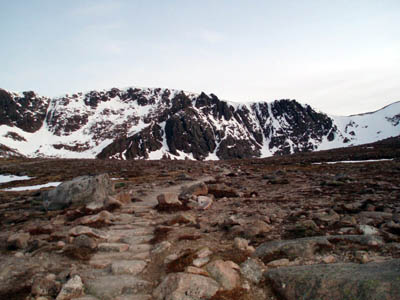
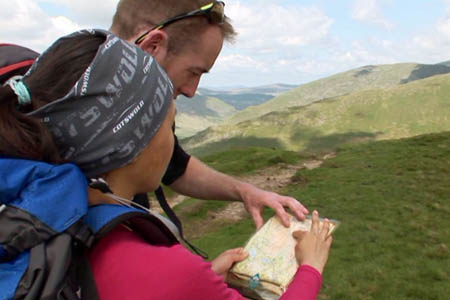
Martin
09 September 2009Many years ago on my only trip up the Ben, I was lured around to have a look at the north face, and then (having dodged falling rocks) decided to go on up the scree slope to the col at the top. After an "interesting" hour on the loose stuff I reached the top, to find a sign reading "for descent in winter only", or something like that. Not sure how useful it was....
Having said that, we agreed as we trudged down the tourist path that if we'd come up that way we'd probably have given up out of boredom before reaching the summit.
MacKenzie
09 September 2009recently climbed Ben Nevis Via the Carn mor dearg arête and once i finished the Arête i came across that sign you're on about i've only seen people descending at that bit never acceding that wouldn't be very enjoyable.
it's there for to be used as a tool for a quick abseil back down to the SMC Hut in the Coirre.
Bill Wilson
16 September 2009I recently completed another east west traverse of Aonach Eagach I once again descended the scree paths to the west of Sgorr Nam Fiannaidh between it and the Pap of Glencoe this is the " Safe Route " I saw over 70 people on the ridge that day none shared my descent route. Speaking with members of Oban/Glencoe Mountain rescue teams in the Clachaig that evening, It was clear they would not advise descent of the path adjacent to the Clachaig Gully. It has also been removed as a footpath from the latest edition of Harveys Superwalker Glencoe maps why do so many walkers still insist on using this path it is very dangerous and should be avoided. Unfortunatly the mountains lure many who cant take good advice the descent south from the summit Cairn of S N F is a dry weather option. If in any doubt Head due west from the summit and suffer the longer walk off. Its a long descent to the road especially after a long day when mistakes are easily made but at least you will live to tell the tale.
The Clachaig Gully is a No No
David Jones
05 August 2017Someone I knew professionally died on the Clachaig Gully. At the time, before I'd started hill walking, I was rather mystified that someone could die in Glencoe! Some years later the party I was with on a guided holiday in Scotland stopped at the Clachaig Inn where the hazardous nature of the descent is apparent.
I'd have thought that Aonach Egach walkers would be aware of the hazards from the guide books, or ought to be before they venture onto the ridge. So signs ought not to be need here.
I'd make an exception for Ben Nevis where the novices are so numerous, if only to save the time of the MRT.
Dave
Paul
05 July 2021If a sign saves one life, it will be worth it. If a sign listed fatalities, it would scare away the unprepared, and add notoriety for the experienced.